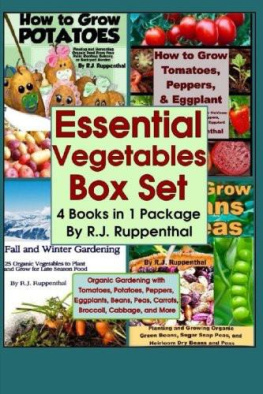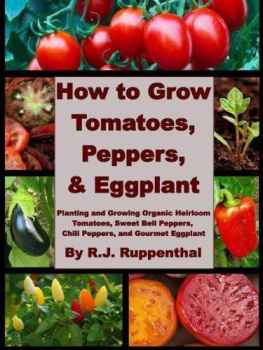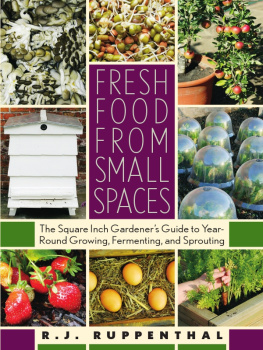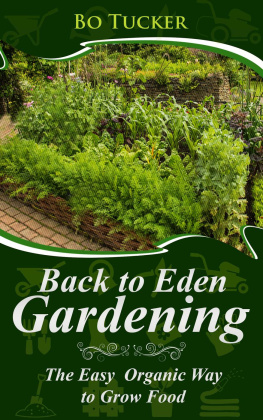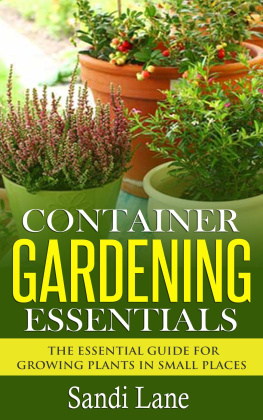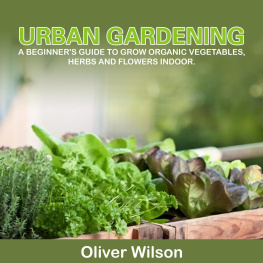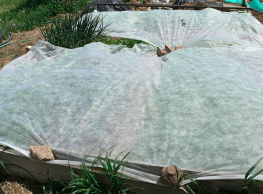Essential Vegetables Box Set (4 Books in 1 Package): Organic Gardening with Tomatoes, Potatoes, Peppers, Eggplants, Broccoli, Cabbage, and More
By R.J. Ruppenthal, Attorney/Professor/Garden Writer
All Rights Reserved 2012 R.J. Ruppenthal
Introduction to this Set
This book is a bundled package that combines four practical books. Together, they can help you grow over 30 different delicious organic vegetables in your home garden. These works are particularly helpful for beginning gardeners and anyone who has never grown these vegetables. They are appropriate for urban gardeners as well as others, since they cover both traditional gardening and container gardening for small spaces.
Each of these books is available separately, but this package gives you a discount on all four. The first book, How to Grow Potatoes , is one of my most popular gardening books. Everyone should grow these simple and delicious tubers in their yard, or in containers on their patio, doorstep, rooftop, balcony, or deck. I wrote Potatoes because there was a lack of good information out there on both traditional and innovative methods of spud growing. I saw some good books, but who really wants to pay $20 for a huge book about potatoes?
This book covers the basics of potato growing, walks you through all the information you need on selecting different types, proper soil, materials, planting, fertilization, watering, care, harvest, and storage. It also introduces you to some creative ideas for getting plants to produce more potatoes. Just the basics, no fluff, at a very low price people can afford.
Fast forward to the next book in this set, which is How to Grow Tomatoes, Peppers, and Eggplant . This is one of my newer books. Tomatoes are most peoples favorite homegrown gardening crop, and for good reason. Anyone who has tasted a homegrown tomato will tell you how much better it tastes than anything in the store. Peppers, including sweet peppers and spicy chili peppers, generally are recognized as the second most popular home food crop in the United States, Top 10 in the United Kingdom, and popular elsewhere also.
Why eggplants? As Asian and Italian gardeners will tell you, theyre really good when grown at home. As with tomatoes and peppers, the home organic gardener suddenly has access to dozens of different varieties of eggplants (hundreds, or maybe thousands in the case of tomatoes and peppers!). And it turns out they are WAY yummier than the store-bought ones.
The neat thing is that tomatoes, peppers, and eggplants are all so closely related that their growing needs and habits are very similar. So if you learn to grow tomatoes well (as you will from this book!), then you can pop a few eggplant and pepper plants, treat them the same way, and they will reward you with lots of delicious organic vegetables. Once again, this book is a concise guide to growing these three veggies, leading you through proper site selection, planting them from seed or seedling, appropriate support from stakes, cages, or trellises, proper watering, fertilization, and care, and three advanced tips for pampering your plants into producing lots and lots of really good tomatoes, peppers, and eggplants. Its all here.
Third in this set is my How to Grow Beans and Peas book. With the rising cost of food, more people need to learn how to grow some of their own protein. These wonderful legume plants provide you with a dirt cheap source of high quality protein and vegetables in both warm and cool season weather. Beans, peas, lentils, soybeans, mung beans, adzuki beans, cowpeas, limas, green (snap) beans, sugar snap peas, snow peas, runner beans, fava beanstheyre all in here. You will learn the differences between bush and pole varieties and how you can make the most of your garden or container growing space using either one.
If you have never tasted heirloom beans, you are in for a treat. This book introduces you not only to growing these wonderful foods. It also provides you with a range of important sources for obtaining rare, heirloom bean seeds. These are the foods our ancestors grew, and many of them taste far better than the bland, pithy beans to which we have become accustomed. This small book is another thorough yet concise guide to garden and soil preparation, obtaining the best seeds, planting, trellising, watering, fertilizing, care, harvesting, drying, and storage of beans and peas. After you finish reading this book, I hope you will join me in planting some heirloom beans to carry on some of these rare varieties that taste so great and have such important histories behind them.
Finally, you get one more book in this set: Fall and Winter Gardening . This is a de facto growing guide to 25 cool-weather vegetables. It includes many favorite vegetables such as broccoli, carrots, cabbage, spinach, beets, parsley, collards, kale, and lettuce. This book also covers some related plants you may have not considered, but which can grace your cool season vegetable beds, raised beds, and containers with easy-to-grow and exotic appeal: arugula, bok choy (pak choi), endive, mache, orach, cress, and more. This book will guide you through garden preparation, determining when to plant in your area for a late-season harvest, proper organic care and fertilization, extending your season, and harvesting and storing your produce so that you can eat fresh food all year long. Again, it sticks to the basics and covers what you need in a small package.
Since I started publishing my works for Kindle, and later converting some of them into small print editions on Amazon, these short growing guides have been my focus. People like paying less, getting the needed information on how to grow their own food, and calling it a day. So I dont include much fluff in my works. And this marks the first time I have published a longer work on Kindle, though it is simply a combination of earlier works. Here they are. Enjoy!
How to Grow Potatoes: Planting and Harvesting Organic Food From Your Patio, Rooftop, Balcony, or Backyard Garden (Booklet)
By R.J. Ruppenthal, Attorney/Professor/Garden Writer
Two Secret Tips for Getting More (and More Delicious) Potatoes
All Rights Reserved 2012 R.J. Ruppenthal
Chapter 1: Why Grow Potatoes? Five Great Reasons
Potatoes are one of the simplest food crops to grow at home. In this booklet, you will learn how to plant and grow potatoes in any sized garden. Even if you have no garden at all, and merely a doorstep, patio, rooftop, balcony, or deck, you can grow potatoes in very small spaces. Learn which type of containers potatoes thrive in, producing bigger harvests than youll ever get from a bed in the ground. Learn how to select potatoes that mature earlier than others, giving you a quick harvest even in a short season climate with cold winters.
Be More Self-Sufficient
No other food crop allows you to do so much with so little as the potato. In fact, this is the most productive food staple you can produce at home. Just imagine how much space it would take to grow enough wheat, rye, oats, barley, or rice to feed a family. Yet you can grow enough potatoes on your doorstep to feed a person for days.
Potatoes pack more food energy per square foot than anything else you can grow. The only other food that even comes close is corn, but corn cannot touch the humble spud. Potatoes can produce more than 15,000 pounds per acre, while corn produces closer to 6,000 pounds. Here are the yields of some common food staples in terms of calories per acre. Yes, I know you and I are dealing in square feet (and maybe even square inches), but this gives you a sense of potato power:
Potatoes: 17.8 million calories per acre
Corn: 12.3 million calories per acre
Wheat: 6.4 million calories per acre
Soybeans: 2.1 million calories per acre
Beef: 1.1 million calories per acre
Next page
